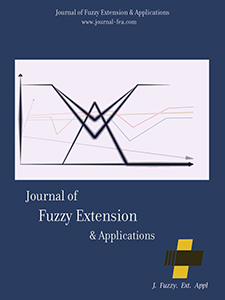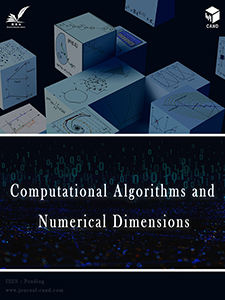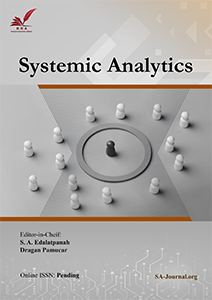Optimizing Compressive Strength and Durability of Foamed Concrete with Fine Lightweight Aggregate and Fly Ash Incorporation
Keywords:
Compressive strength, Lightweight foamed concrete, Slump test, ELM, SVMAbstract
Foamed Concrete (FC) is a kind of lightweight concrete distinguished by including a stable prepared foam in the mix fraction, resulting in a network of air gaps forming inside the material. Its physical and mechanical qualities are heavily impacted by its microstructural characteristics, which are connected to many factors such as the volume of foam, the presence of mineral or chemical additions, mixing process features, and so on. This study aimed to test the impact of the addition of fine LWA and the partial substitution of cement with Fly Ash (FA) on the qualities of hardened FC, specifically the compressive strength of LWA FC, as well as its durability. Ordinary Portland cement CEM I 52.5R and FA class F (25 wt%) are used to replace the cement. The water-to-binder ratio (w/b) for all mixtures is set at 0.40, while the paste foam proportion is set at 1:2. Lightcrete 400, a foaming agent manufactured by Sika Germany, is utilized to make the foam. To achieve a concrete slump flow diameter greater than 500 mm, a custom-made polycarboxylate superplasticizer is used without a de-foaming agent compatible with the foaming agent. As a hybridized model, an Extreme Learning Machine (ELM) and Support Vector Machine (SVM) are used to improve the precision of experimental testing and data. Using the regression indices RMSE, R2, r, and MAE, the experimental findings demonstrated that, for a given bulk density, the integration of fine lightweight aggregate has a considerable effect on the development of compressive strength based on the features of the lightweight aggregate. Nevertheless, the thermal conductivity of FC is largely determined by its dry density and aggregate composition. Also, the use of fine LWA greatly minimizes the drying contraction of FC.
References
[1] Hunaiti, Y. M. (1997). Strength of composite sections with foamed and lightweight aggregate concrete. Journal of materials in civil engineering, 9(2), 58–61. https://doi.org/10.1061/(ASCE)0899-1561(1997)9:2(58)
[2] Shariati, M., Ramli Sulong, N. H., & Arabnejad Khanouki, M. M. (2010). Experimental and analytical study on channel shear connectors in light weight aggregate concrete. In Proceedings of the 4th international conference on steel composite structures (pp. 21-23). Research publishing services. https://eprints.qut.edu.au/196792/
[3] Shariati, M., Ramli Sulong, N. H., Sinaei, H., Arabnejad Khanouki, M. M., & Shafigh, P. (2011). Behavior of channel shear connectors in normal and light weight aggregate concrete (experimental and analytical study). Advanced materials research, 168, 2303–2307.
[4] Shariati, M., Ramli Sulong, N. H., Arabnejad Khanouki, M. M., & Mahoutian, M. (2011). Shear resistance of channel shear connectors in plain, reinforced and lightweight concrete. Scientific research and essays, 6(4), 977–983.
[5] Hamidian, M., Shariati, M., Arabnejad, M. M. K., & Sinaei, H. (2011). Assessment of high strength and light weight aggregate concrete properties using ultrasonic pulse velocity technique. International journal of physical sciences, 6(22), 5261–5266.
[6] Shariati, M., Ramli Sulong, N. H., Suhatril, M., Shariati, A., Arabnejad Khanouki, M. M., & Sinaei, H. (2012). Fatigue energy dissipation and failure analysis of channel shear connector
embedded in the lightweight aggregate concrete in composite bridge girders [presentation]. Fifth international conference on engineering failure analysis 1-4 july 2012, hilton hotel, the hague, the netherlands. https://www.researchgate.net/publication/237062154_Fatigue_energy_dissipation_and_failure_analysis_of_channel_shear_connector_embedded_in_the_lightweight_aggregate_concrete_in_composite_bridge_girders
[7] Rajaei, S., Shoaei, P., Shariati, M., Ameri, F., Musaeei, H. R., Behforouz, B., & Brito, J. (2021). Rubberized alkali-activated slag mortar reinforced with polypropylene fibres for application in lightweight thermal insulating materials. Constr build mater, 270, 121430. DOI:10.1016/j.conbuildmat.2020.121430
[8] Lim, S. K., Tan, C. S., Li, B., Ling, T.-C., Hossain, M. U., & Poon, C. S. (2017). Utilizing high volumes quarry wastes in the production of lightweight foamed concrete. Construction and building materials, 151, 441–448. https://www.sciencedirect.com/science/article/pii/S0950061817312321
[9] Lim, S. K., Tan, C. S., Chen, K. P., Lee, M. L., & Lee, W. P. (2013). Effect of different sand grading on strength properties of cement grout. Construction and building materials, 38, 348–355. https://www.sciencedirect.com/science/article/pii/S0950061812006228
[10] Zhao, X., Lim, S. K., Tan, C. S., Li, B., Ling, T. C., Huang, R., & Wang, Q. (2015). Properties of foamed mortar prepared with granulated blast-furnace slag. Materials, 8(2), 462–473. https://www.mdpi.com/1996-1944/8/2/462
[11] Lim, S. K., Tan, C. S., Lim, O. Y., & Lee, Y. L. (2013). Fresh and hardened properties of lightweight foamed concrete with palm oil fuel ash as filler. Construction and building materials, 46, 39–47. https://www.sciencedirect.com/science/article/pii/S0950061813003322
[12] Lim, S. K., Tan, C. S., Zhao, X., & Ling, T. C. (2015). Strength and toughness of lightweight foamed concrete with different sand grading. KSCE journal of civil engineering, 19(7), 2191–2197. https://doi.org/10.1007/s12205-014-0097-y
[13] Raupit, F., Saggaff, A., Tan, C. S., Lee, Y. L., & Tahir, M. M. (2017). Splitting tensile strength of lightweight foamed concrete with polypropylene fiber. International journal on advanced science, engineering and information technology, 7(2), 424–430.
[14] Lee, Y. L., Lim, J. H., Lim, S. K., & Tan, C. S. (2018). Flexural behaviour of reinforced lightweight foamed mortar beams and slabs. KSCE journal of civil engineering, 22(8), 2880–2889. https://doi.org/10.1007/s12205-017-1822-0
[15] Faroug, F., Szwabowski, J., & Wild, S. (1999). Influence of superplasticizers on workability of concrete. Journal of materials in civil engineering, 11(2), 151–157. https://doi.org/10.1061/(ASCE)0899-1561(1999)11:2(151)
[16] Ferrari, L., Kaufmann, J., Winnefeld, F., & Plank, J. (2010). Interaction of cement model systems with superplasticizers investigated by atomic force microscopy, zeta potential, and adsorption measurements. Journal of colloid and interface science, 347(1), 15–24. https://www.sciencedirect.com/science/article/pii/S0021979710002730
[17] Łaźniewska-Piekarczyk, B., Miera, P., & Szwabowski, J. (2017). Plasticizer and superplasticizer compatibility with cement with synthetic and natural air-entraining admixtures. IOP conference series: materials science and engineering, 245(3), 1–8. https://dx.doi.org/10.1088/1757-899X/245/3/032094
[18] Łaźniewska-Piekarczyk, B., Szwabowski, J., & Miera, P. (2015). Superplasticizer compatibility problem with innovative air-entraining multicomponent portland cement [presentation]. Proceedings, 14 th international congress on the chemistry of cement (ICCC). https://repolis.bg.polsl.pl/Content/39657/REPO_43635_2015_Superplasticizer-com_0000.pdf
[19] Ziaei-Nia, A., Shariati, M., & Elnaz, S. (2018). Dynamic mix design optimization of high-performance concrete. Steel and composite structures, 29(1), 67–75.
[20] Toghroli, A., Mehrabi, P., Shariati, M., Trung, N. T., Jahandari, S., & Rasekh, H. (2020). Evaluating the use of recycled concrete aggregate and pozzolanic additives in fiber-reinforced pervious concrete with industrial and recycled fibers. Construction and building materials, 252, 118997. https://doi.org/10.1016/j.conbuildmat.2020.118997
[21] Mydin, M. A. O. (2011). Potential of using lightweight foamed concrete in composite load-bearing wall panels in low-rise construction. Concrete research letters, 2(2), 213–227.
[22] Jones, M. R., & Mccarthy, A. (2005). Preliminary views on the potential of foamed concrete as a structural material. Magazine of concrete research, 57(1), 21–31.
[23] Hamidah, M. S., Azmi, I., Ruslan, M. R. A., Kartini, K., & Fadhil, N. M. (2005). Optimisation of foamed concrete mix of different sand-cement ratio and curing conditions. Use of foamed concrete in construction: proceedings of the international conference held at the university of dundee, scotland, uk on 5 july 2005 (pp. 37–44). Thomas Telford Publishing. https://www.icevirtuallibrary.com/doi/abs/10.1680/uofcic.34068.0005
[24] Jones, M. R., & McCarthy, A. (2006). Heat of hydration in foamed concrete: effect of mix constituents and plastic density. Cement and concrete research, 36(6), 1032–1041. https://www.sciencedirect.com/science/article/pii/S0008884606000068
[25] Kearsley, E. P., & Wainwright, P. J. (2001). The effect of high fly ash content on the compressive strength of foamed concrete. Cement and concrete research, 31(1), 105–112. https://www.sciencedirect.com/science/article/pii/S0008884600004300
[26] Kearsley, E. P., & Wainwright, P. J. (2002). Ash content for optimum strength of foamed concrete. Cement and concrete research, 32(2), 241–246. https://www.sciencedirect.com/science/article/pii/S0008884601006664
[27] Nambiar, E. K. K., & Ramamurthy, K. (2006). Models relating mixture composition to the density and strength of foam concrete using response surface methodology. Cement and concrete composites, 28(9), 752–760. https://www.sciencedirect.com/science/article/pii/S0958946506001107
[28] Nambiar, E. K. K., & Ramamurthy, K. (2008). Models for strength prediction of foam concrete. Materials and structures, 41(2), 247–254. DOI:10.1617/s11527-007-9234-0
[29] Ramamurthy, K., Kunhanandan Nambiar, E. K., & Indu Siva Ranjani, G. (2009). A classification of studies on properties of foam concrete. Cement and concrete composites, 31(6), 388–396. https://www.sciencedirect.com/science/article/pii/S0958946509000638
[30] Jalal, M. D., Tanveer, A., Jagdeesh, K., & Ahmed, F. (2017). Foam concrete. International journal of civil engineering research, 8(1), 1–14.
[31] Raj, A., Sathyan, D., & Mini, K. M. (2019). Physical and functional characteristics of foam concrete: a review. Construction and building materials, 221, 787–799. https://www.sciencedirect.com/science/article/pii/S0950061819314771
[32] Abd Elrahman, M., El Madawy, M. E., Chung, S. Y., Sikora, P., & Stephan, D. (2019). Preparation and characterization of ultra-lightweight foamed concrete incorporating lightweight aggregates. Applied sciences, 9(7), 1447. https://doi.org/10.3390/app9071447
[33] Ramli, M., Kwan, W. H., & Abas, N. F. (2013). Strength and durability of coconut-fiber-reinforced concrete in aggressive environments. Construction and building materials, 38, 554–566. https://www.sciencedirect.com/science/article/pii/S0950061812006630
[34] Munir, A., Abdullah, Huzaim, Sofyan, Irfandi, & Safwan. (2015). Utilization of palm oil fuel ash (POFA) in producing lightweight foamed concrete for non-structural building material. Procedia engineering, 125, 739–746. https://www.sciencedirect.com/science/article/pii/S1877705815034360
[35] Memon, I. A., Jhatial, A. A., Sohu, S., Lakhiar, M. T., & Hussain, Z. (2018). Influence of fibre length on the behaviour of polypropylene fibre reinforced cement concrete. Civil engineering journal, 4(9), 2124–2131.
[36] Grote, D. L., Park, S. W., & Zhou, M. (2001). Dynamic behavior of concrete at high strain rates and pressures: i. experimental characterization. International journal of impact engineering, 25(9), 869–886. https://www.sciencedirect.com/science/article/pii/S0734743X01000203
[37] Li, Q. M., & Meng, H. (2003). About the dynamic strength enhancement of concrete-like materials in a split Hopkinson pressure bar test. International journal of solids and structures, 40(2), 343–360. https://www.sciencedirect.com/science/article/pii/S0020768302005267
[38] Asprone, D., Cadoni, E., & Prota, A. (2009). Experimental analysis on tensile dynamic behavior of existing concrete under high strain rates. ACI structural journal, 106(1). http://wpage.unina.it/d.asprone/8.pdf
[39] Zhou, J., Chen, X., Wu, L., & Kan, X. (2011). Influence of free water content on the compressive mechanical behaviour of cement mortar under high strain rate. Sadhana, 36(3), 357–369. DOI:10.1007/s12046-011-0024-6
[40] Tedesco, J. W., Powell, J. C., Ross, C. A., & Hughes, M. L. (1997). A strain-rate-dependent concrete material model for ADINA. Computers & structures, 64(5), 1053–1067. https://www.sciencedirect.com/science/article/pii/S0045794997000187
[41] Malvar, L. J., & Ross, C. A. (1998). Review of strain rate effects for concrete in tension. ACI materials journal, 95, 735–739.
[42] Katayama, M., Itoh, M., Tamura, S., Beppu, M., & Ohno, T. (2007). Numerical analysis method for the RC and geological structures subjected to extreme loading by energetic materials. International journal of impact engineering, 34(9), 1546–1561. https://www.sciencedirect.com/science/article/pii/S0734743X06002764
[43] Zhou, X. Q., & Hao, H. (2008). Mesoscale modelling of concrete tensile failure mechanism at high strain rates. Computers & structures, 86(21), 2013–2026. https://www.sciencedirect.com/science/article/pii/S0045794908001259
[44] Cadoni, E. (2010). Dynamic characterization of orthogneiss rock subjected to intermediate and high strain rates in tension. Rock mechanics and rock engineering, 43(6), 667–676. DOI:10.1007/s00603-010-0101-x
[45] Burges, C. J. C. (1998). A tutorial on support vector machines for pattern recognition. Data mining and knowledge discovery, 2(2), 121–167. DOI:10.1023/A:1009715923555
[46] Cristianini, N., & Shawe-Taylor, J. (2000). An introduction to support vector machines and other kernel-based learning methods. Cambridge university press.
[47] Lewis, J. P. (2004). Tutorial on SVM. CGIT. https://course.ccs.neu.edu/cs5100f11/resources/jakkula.pdf
[48] Vapnik, V. N. (1999). An overview of statistical learning theory. IEEE transactions on neural networks, 10(5), 988–999.
[49] Li, L. N., Ouyang, J. H., Chen, H. L., & Liu, D. Y. (2012). A computer aided diagnosis system for thyroid disease using extreme learning machine. Journal of medical systems, 36(5), 3327–3337. https://doi.org/10.1007/s10916-012-9825-3
[50] Huang, G. B., Wang, D. H., & Lan, Y. (2011). Extreme learning machines: a survey. International journal of machine learning and cybernetics, 2(2), 107–122. DOI:10.1007/s13042-011-0019-y
[51] Feng, G., Qian, Z., & Zhang, X. (2012). Evolutionary selection extreme learning machine optimization for regression. Soft computing, 16(9), 1485–1491. DOI:10.1007/s00500-012-0823-7
[52] Liu, Y., He, B., Dong, D., Shen, Y., Yan, T., Nian, R., & Lendasse, A. (2015). ROS-ELM: a robust online sequential extreme learning machine for big data analytics. Proceedings of ELM-2014 volume 1 (pp. 325–344). Cham: springer international publishing.
[53] Mohammadhassani, M., Nezamabadi-Pour, H., Suhatril, M., & Shariati, M. (2013). Identification of a suitable ANN architecture in predicting strain in tie section of concrete deep beams. Structural engineering & mechanics, 46(6), 853–868.
[54] Toghroli, A., Mohammadhassani, M., Suhatril, M., Shariati, M., & Ibrahim, Z. (2014). Prediction of shear capacity of channel shear connectors using the ANFIS model. Steel and composite structures, 17(5), 623–639. http://dx.doi.org/10.12989/scs.2014.17.5.623

 Metrics
Metrics



